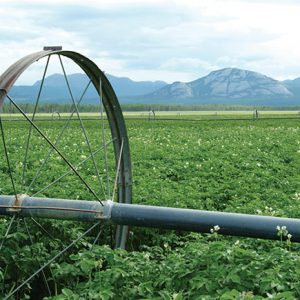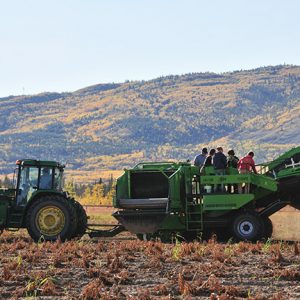
Features
Business Management
Golden opportunity for the adventurous
Growing spuds in the north is not for the faint of heart.
June 19, 2021 By Madeleine Baerg
 ukon Grain Farm’s success is thanks to its committed and enthusiastic staff team, say owners Steve and Bonnie Mackenzie-Grieve (both in red and black plaid). All photos courtesy of Steve and Bonnie MacKenzie-Grieve.
ukon Grain Farm’s success is thanks to its committed and enthusiastic staff team, say owners Steve and Bonnie Mackenzie-Grieve (both in red and black plaid). All photos courtesy of Steve and Bonnie MacKenzie-Grieve.
In 2004, Steve and Bonnie Mackenzie-Grieve thought they were ready to slow down a little. Their two southern Alberta businesses – a potato storage insulation company and a fish farm wholesale business – were thriving, but not allowing time for the exploring, innovating and hands-in-the-dirt farming they dreamed of. So, they passed the businesses on to their son, Rob, packed their bags and headed north. Far north.
Seventeen years later, it’s clear that part of the Mackenzie-Grieves’ plan worked out: as Canada’s most northern commercial potato producer, the couple is adventuring and old-fashioned pioneering on a daily basis. The part of the plan about slowing down, however? That hasn’t worked out at all.
“We came up here as a sort of semi-retirement, but we’re busier now than we ever were in southern Alberta,” Steve Mackenzie-Grieve admits with a laugh. “But we’re different busy: now we’re busy on a farm instead of travelling all over the province. We’re doing what we want to be doing.”
The Mackenzie-Grieves run Yukon Grain Farm, the Yukon Territories’ largest and most productive farm business. Located just a few minutes from Whitehorse, Yukon Grain Farm includes between 200 and 300 acres of grain that is processed into livestock feed on-farm, six acres of carrots, and two to three acres each of parsnips, cabbages, and several other vegetables. The farm is also home to 24 acres of potatoes: the most lucrative of all the acres and what Mackenzie-Grieve calls the base of their operation.
There are upsides to farming in the Yukon. The summer sun shines 19 hours a day. “You can almost see plants growing,” he says. “You go out there one day and they’re ankle height; the next day they’re knee height. It’s incredible.” And there are far fewer insect pests and crop disease issues, both because of how isolated fields are and the winter’s sustained cold.
That said, the Mackenzie-Grieves have to contend with a wide variety of challenges unique to farming in the Yukon.
“I think it’s fair to say that in almost all ways, it’s more difficult trying to grow food up here,” he says.
Every crop input has to be shipped north at great cost: think $8,000 per B-train truckload. Equipment is impossible to come by locally: they had to ship in a custom-built one-row potato harvester from Belgium and a second-hand cup planter from Alberta. Equipment repair is even less accessible, unless you’re willing to pay for a repairman to fly up from British Columbia or Alberta.
Many crops – in fact, most crops – can’t successfully reach maturity in the Yukon’s ultra-short growing season.
“With beans, it’s highly unlikely they’ll ever mature. Peas are kind of a crapshoot. Some years they’ll do OK. This summer, they reached six feet, but they never matured because the spring was cold and the summer never really got warm. But you have to grow them. You need something else in rotation, because if you grow grain on grain on grain, you’ll end up with a field full of foxtail and wild oats,” Mackenzie-Grieve says.
The small size of the Yukon’s agriculture industry also brings challenges. The Yukon is home to only about 150 farms, of which only a small portion are producing at any kind of commercial level. As of 2017 – the most recent year for which statistics are available – the Yukon’s farms generated combined returns of about $4.3 million. The industry’s small size means there is no industry infrastructure.
“The toughest thing is we have to do it all ourselves: grow it, store it, process it, market it, and that’s for every crop we produce,” Mackenzie-Grieve says.
There’s also no industry infrastructure for exporting, which means all crops grown in the Yukon must be sold exclusively to the roughly 40,000 people who live in the Yukon.
“We are very limited by our market. Our market is so small that you have to do a bunch of things – you have to diversify into multiple crops – to make a farm work. The first step is figuring out what you can grow; the second step is figuring out what you can sell,” Mackenzie-Grieve says.
Perhaps most challengingly, the small size of the industry means front-runners like the Mackenzie-Grieve family need to figure everything out themselves. Successfully producing potatoes has been a very, very steep learning curve, he says.
He admits he started all wrong. They brought potato seed from the south, so carried in scab and various pests. “We should have started from scratch or gotten some really high-generation seed,” he says. “It’s taken us a long time to get on top of those issues.”
They tried a lot – a lot, he says emphatically – of varieties. Most were a disaster.
- More than 19 hours of daylight during the Yukon’s summer days allow some varieties of potatoes to achieve skin set despite a window of just 50 days from emergence to top-kill.
- Farming in the Yukon presents many challenges, but growers are connected to consumers in a unique way.
“Most varieties don’t work here due to size or skin set. You can’t harvest a potato that’s not ready. That’s where we’ve learned some hard lessons,” he says.
“Yield is very secondary to skin set. We can even do with a smaller variety: they just have to be able to get to a harvestable condition fast enough.”
Consider the math: the earliest they can get in to plant is the third week of May. They hope for emergence by the second or third week of June, but often don’t see potato plants popping up until nearly the end of that month. Top kill has to happen the first week of August – only about 50 days from emergence – so harvest can happen the first week of September.
“It all needs to work out exactly right or they’re not going to get skin set. When it works, they’re beautiful: the skins are so nice and clean and soft. They’re an easy potato to sell if you can get skin set,” he says. “But it doesn’t always work.”
They’ve had the most luck with Sylvana. Though they might not be the best for consistency of shape, they have been the most successful variety for skin set, customers like their taste, and he likes their disease package.
Unfortunately, not everyone shares Mackenzie-Grieve’s enthusiasm: Sylvana was just discontinued as a production variety in 2020.
“We have some of our own seed saved, but not that much,” he says. “Now that they’ve quit reproducing them, we’ll have to find a new variety.”
That will be challenging, since getting seed to the Yukon is expensive and inconsistent, and few sellers want to waste time with the small quantities he needs for trialling.
Despite the challenges of farming in the Yukon, there’s nowhere he’d rather be.
He loves growing for an appreciative audience.
“It’s a very different game up here. When you’re farming in the south, it’s all about production and cost. You grow, you sell, it’s gone and that’s it. Here, we are very connected to the people who actually consume the food we grow. We get lots of feedback. The rest of the farming industry has kind of lost that. Our customers are really, really excited to be supporting local.”
He loves working with the farm’s half-dozen year-round staff, despite the fact that finding anyone with agricultural knowledge in the Yukon is very difficult.
“An ag background is good, but motivation is better,” he says. “The reason our farm works is because our farm staff love growing stuff and being part of this team.”
And, Mackenzie-Grieve truly, deeply loves the Yukon itself.
“Yes, it can be very challenging up here. It is worth it? Absolutely,” he says. “If I could do it all over again, I just wish I’d come up here 20 years earlier.”
Print this page

